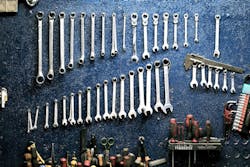The Impact of Litigation Among Diagnostic Tool Providers
In April, asTech parent company Repairify filed a lawsuit against collision repair scan tool manufacturer AirPro over alleged false or misleading information regarding asTech.
AirPro is a combination of OE and independent proprietary software and designed to deliver multiple calibrations needed during and after repairs, and offer programming for multiple replacement control modules. The asTech device is a remote diagnostic tool that allows collision shops and repair technicians to have a vehicle scanned before or after repair work is done.
The two companies waited for an update on a preliminary injunction filed that would prevent AirPro from publishing its Truth Campaign on its website, in which it details how its device works and counters claims made by asTech. The injunction followed the two companies trading cease and desist letters over each other’s comments in April. In July, the lawsuit was dismissed.
In light of the litigation, Doug Kelly, CEO of asTech, says that body shop operators often aren’t aware of which questions to ask when it comes to scan tools and devices.
The legal battle could potentially cause some confusion for shop operators who are in the process of choosing and investing in a scan tool. Because of that, FenderBender took a deep dive into the matter to closely analyze the allegations made by both parties.
Claims involved in the lawsuit raise questions regarding how quickly a diagnostic scan can be completed, how safe the tool is, and whether each device is updated to meet the standards of technology in modern vehicles.
Allegations Arise
Lonnie Margol, CEO of AirPro Diagnostics started the company in 2016 after founding, operating and inventing the asTech device. Not long after the AirPro Diagnostic device came to the market, asTech sued the company, claiming that it was falsely advertising the product and its capabilities. It claimed the AirPro was unable to deliver true completion scans because the only way to perform them was by using factory scan tools.
“We invented the term ‘completion scan’ with asTech and did scans all the time through the asTech using mostly aftermarket tools,” Margol says. “We completely understand what is necessary.”
Margol says that asTech claimed only the use of OEM scan tools were required and the AirPro couldn’t provide completion scans by using aftermarket tools.
“Autel, Snap-On, and other aftermarket scan tools, in addition to the AirPro, were delivering diagnostic and completion scans showing the marketplace that scans can be done with an aftermarket scan tool that uses the same OEM source code as OEM tools,” Margol says.
AirPro filed a $10 million counter lawsuit against asTech in return.
“I was happy about the litigation because it gave us the opportunity to bring out the real facts through sworn testimony in federal court,” Margol says.
Doug Kelly, CEO of asTech, says that false claims against his product include how AirPro is saying it has limitations on calibrations.
“That is false. We can calibrate anything over the internet,” Kelly says. “We choose not to calibrate ADAS in most cases unless it meets three criteria.”
The Devices’ Differences
Margol says AirPro has been tested and approved by General Motors and Subaru engineers for use in their certified shops. He says that the AirPro scan tool uses OEM software that’s loaded into the AirPro scan tool.
Kelly says that asTech has been approved by Enterprise, Chrysler and Subaru.
The AirPro tool is placed in body shops and glass installers as a gateway to AirPro’s remote scanning and calibration services for a fairly small set-up fee.
Meanwhile, asTech, in the lawsuit, claimed “That, due to the number of makes and models of cars available and the inconsistency of when the requests come in, it is mathematically impossible for us to respond within 10 minutes,” says Margol. “It’s totally untrue.”
According to Margol, AirPro often measures its response time and, so far in 2019, begins delivering its service, on average, in less than two minutes. Once a repair shop submits a request, it shows up on the dashboard of every AirPro technician. Each technician aims to begin service as quickly as possible.
Shop employees, through AirPro’s ORION software, can see how many requests are in queue at all times. If eight minutes pass by, then a buzzer goes off which alerts technicians that a scan request is waiting on the board.
Meanwhile, Kelly says the asTech is a proprietary device that connects to the car and works with any scan tool. Technicians can connect the device, then go to asTech’s website to submit a service request. An OEM master technician will send a message to the device noting that a scan is about to begin. Once completed, the master technician will transfer a full scan report to the shop.
“The problem with companies like AirPro and other aftermarket providers is that when you make claims it does the same as the OEM factory tool, when someone asks for that data, there is no supporting data to support the claim,” Kelly says.
He says that aftermarket tools might see only 19 modules but OEM tools might see 21. Yet, there is no warning to technicians alerting them that modules were missed.
Kelly says asTech specifies the minimum requirements a shop needs to be able to use the tool properly and if they meet those requirements there shouldn’t be issues with the tool.
“If someone has a poor internet connection then it is possible it will affect our success,” Kelly says.
Litigation’s Impact on Body Shops
“AirPro remains confident that its ‘Truth Campaign,’ listed on our website, can easily be verified through an independently conducted, side-by-side comparison …” Margol, the AirPro CEO, says.
Kelly, the CEO of asTech, recommends that shop operators ask any vendor of any diagnostic tools and services about how many cars they tested and what the results have been.
“Shops should not be investing in ADAS calibrations unless they’re OEM approved and that’s our position on it,” Kelly says.



